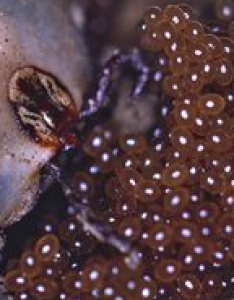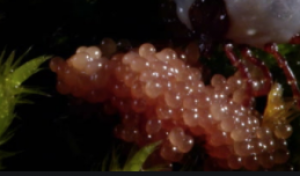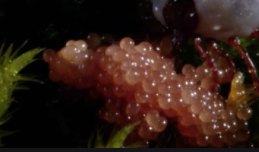Tick nests are easy to identify, and if you find one, do humanity a favor and get rid of it!
Like every other creature on the planet, ticks have to start somewhere. Whether you are talking about deer ticks, wood ticks, or other common ticks, a tick usually enters this world by way of an egg in a nest. Being able to spot these nests is one important step in knowing where your ticks are originating from as well as potentially taking steps to curb the tick population. In this article, we will talk about tick nests, what they are, where to find them, what you can do to get rid of them, and even a little education on how ticks breed as well as when their nests are most active.
What Does a Tick Nest Look Like?
First off, tick nests are not really nests at all, but rather masses of eggs. Generally small, unstructured piles that are generally between 0.2 and 0.4 inches long, nests can be found anywhere from leafy ground surrounded by tall grass to the linings of your coat. Ticks often will try to find an environment for their nest that is somewhat soft and warm, which is why they will sometimes try to create it indoors if they can.
generally between 0.2 and 0.4 inches long, nests can be found anywhere from leafy ground surrounded by tall grass to the linings of your coat. Ticks often will try to find an environment for their nest that is somewhat soft and warm, which is why they will sometimes try to create it indoors if they can.
You may also see tick nests in brush piles, wood piles, or even on vegetation. The nest will often be in a place where the tick would not expect the eggs to be disturbed, which is why you often don’t see them in plain sight.
The eggs are going to be brown, tan, or a dark golden color. They look a bit like plastic or jelly to the naked eye.
When Do you Find Tick Nests?
Because of the long reproduction cycle for ticks, you can actually find an egg at almost any time. Ticks lay eggs in the spring, but they don’t hatch until late the next winter, which means that the eggs in the “nest” will be visible all spring, summer, and fall. They will also be visible in winter, too, provided you don’t live in an area that gets coated by snow from December through March.
What to do With a Tick Nest
If you find yourself in the presence of a tick nest, fear not! There are multiple ways to safely dispatch them, and none are costly at all in terms of effort or money. The first option you have is using rubbing alcohol or even the classic, caramel- colored listerine mouthwash. Simply pour the liquid onto the nest so that there is enough to have made contact with every egg, and then lay a paper towel or tissue of some sort that is damp with the liquid over the nest for five to ten minutes. The liquid should kill the eggs on contact, but it is never a bad idea to let it sit for a little while just to make sure.
colored listerine mouthwash. Simply pour the liquid onto the nest so that there is enough to have made contact with every egg, and then lay a paper towel or tissue of some sort that is damp with the liquid over the nest for five to ten minutes. The liquid should kill the eggs on contact, but it is never a bad idea to let it sit for a little while just to make sure.
The second option you have, which for obvious reasons should only be used if you are outside, is burning the nest. As long as you are outside and the nest is in an area that is not dangerously flammable, this is a reliable way to go about getting rid of the nest because they are so small in area. Once you have located the nest, wet it with some sort of lighter fluid (anything from gasoline to barbeque liquid fuel will do) and add a fuel-dampened tissue on top if you so desire. Once this is done, go ahead and light the nest with a match or some other safe method of ignition, and let the flames burn out.
Again, if you burn, be sure you are practicing all of the safety precautions listed on any products you choose to use, and never to do near a building, in a restricted fire area, around kids, or anywhere with a risk of wildfires.
After the nest has been burnt or poisoned and is successfully dealt with, just wipe and/or sweep it up into some sort of container and throw it away. The nests can be safely disposed of this way.
How to Prevent Future Tick Nests
If you live in an area prone to high tick levels or you already have experienced a lot of ticks in your living environment, you can make a preemptive strike against the future waves of ticks by creating what are known as “tick-mines” or “tick-cubes”.
You can buy pre-made tick tubes.
Or, you can make them. To make these little anti-tick devices, follow these four steps:
- Grab a cardboard tube (or box, if a tube is difficult to come by), a coil or block of cotton, and a container of the
 pesticide permethrin.
pesticide permethrin. - Work to place the cotton inside of the box or tube. It also helps to tear up the cotton into somewhat smaller pieces, because we want it to be easily moved out of the container.
- CAREFULLY wet the cotton with permethrin. Though this pesticide excels at eliminating ticks and their nests, it is also quite efficient at harming humans through their skin! A smart way to go about doing this is making sure not to breathe any fumes in and to wear rubber gloves while handling the pesticide.
- Set the tube/box somewhere easily accessible to mice and other rodents, such as outside in bushes or near a shed.
The beauty of tick tubes is that you get to merely make them and leave them. As mice and other rodents take from the cotton supply to make their own nests (these animals are what most ticks feed and get their start on), they will get the permethrin on their own fur, thereby causing them to be toxic to ticks. As ticks go to feed on them, then, they will die very quickly. Ticks also often nest in similar areas to mice, and the presence of permethrin in these areas will do very well to help stem the tick population.
So How do Ticks Mate, and What is The Lifecycle?
When it comes to the mating of ticks, the information is pretty straightforward. In order for any reproduction to occur within a tick population, the female ticks need to feed (fun fact: all ticks that feed on the blood of animals are female). Immediately after feeding, the female ticks mate with the male ticks, consequentially ending up with fertilized eggs.
within a tick population, the female ticks need to feed (fun fact: all ticks that feed on the blood of animals are female). Immediately after feeding, the female ticks mate with the male ticks, consequentially ending up with fertilized eggs.
Ticks will lay eggs in the spring, which is when you will begin to see most tick nests. The eggs then hatch into larvae in the winter, and later grow into nymphs in the spring and/or summer. Ticks are fully grown by fall and/or winter, and then feed and mate to repeat the cycle. As a result of this, ticks will be the most active during the spring, as well as their nests.
Other Tips
During the spring, there are a few measures to take in order to ensure you are properly prepared for tick season:
- Avoid long grass when you can, as this is where most ticks reside. The ticks will wait on the grass, and latch onto any person or animal that walks through. Also wear long pants and/or boots if possible. If you really want to take the fight to the ticks, you can thinly coat your pants and shoes in permethrin as well!
- Use tick repellents.
- Have a spring checkup or two scheduled for any pets you have! Tick season can be absolutely awful for dogs and cats (as I’m sure any owner is aware), and it is essential to do all you can to protect them with pet tick repellents.
- Deploy tick tubes! We already covered the making and use of them, so if you think they would be effective in your area, go ahead and trojan horse those ticks.






